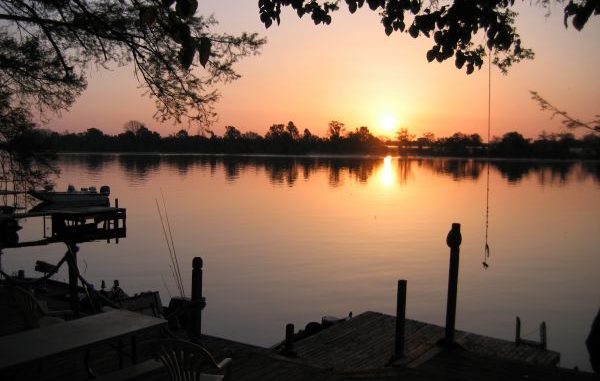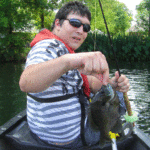
Try a fly on these unique lakes
Once again, the weather prognosticaters had proven that their job is better left to leaf readers and Ouija boards.
I’d taken a good day of vacation to take my daughter Cokie fishing while she was off on Easter break. We were hoping to hit a home run on big bream at Lake Concordia.
The forecast had called for no rain and partly cloudy skies. But as we left the house, ominous clouds on the western horizon appeared. Knowing that fronts travel west to east — a little fact weathermen seem to ignore at times — we grabbed our rain jackets. Just in case.
Concordia is one of several oxbow lakes in east-central Louisiana. Others are Lake St. John, Old River Vidalia, Deer Park Lake, Lake Bruin, Lake St. Joseph, Black River Lake and Lake Cocodrie.
The “live” oxbow lakes — like Deer Park — receive an influx from the Mississippi during high water, and when the river levels fall they offer superb fishing for white bass, crappie and bull bream. Fly fishing can be great at times, but it’s often unpredictable.
The “dormant” oxbows — like Concordia — no longer receive water from the river. But the nutrients the river once provided remain. That means very good numbers of above-average bluegill and redears for the taking.
Most important, these waters are seldom influenced by rainfall, and remain clear/green year ’round. And, as we all know, clear water favors the flyrodder.
The shortest route from my house to Ferriday is on Highway 61, which passes through the scenic elevations of Southwest Mississippi. The highlight is towering 400-foot Mount Doloroso; its snow-capped peak is usually melted off come April. The scenery helps make the 90-minute drive go by faster.
On this day, storms moved in just after we arrived at the lake. So we decided to go 30 minutes north, while the front passed thru, and give Bruin a shot. Bream action in early April on Bruin can be less dependable than Concordia. Being bigger and deeper, peak season usually starts a couple weeks later.
We launched the canoe at Lake Bruin State Park, and started working some cypress trees across from the launch. Early on, Cokie and I each caught a sac-a-lait using fluff butts.
A fluff butt is the flyfisher’s version of the popular marabou crappie jig. Both have marabou tails and chenille bodies. The only difference is that the fluff butt uses a bead for the head.
Cokie then tied on a tussel bug. This fly, developed by Dirk Burton of Baton Rouge, consists of a woven body that gives it great detail — almost lifelike segmentation. Tied wth either bead-chain eyes or tiny dumbell eyes, it gets deep very fast.
The tussel bug proved the trick for finding a few of this lake’s huge redears. Often the fly hit the bottom, and the strike came when Cokie lifted the rod tip.
Pound for pound, gobbules — known as bream to non-flyrodders — are the strongest fish in fresh water. Hooking up with one just short of a pound in weight on a fly rod is an experience you remember long after the trip is over!
Around noon, we reassessed our situation. Almost all the bream we’d caught over the last hour were small. We decided to relocate south to our original destination.
After a short stop for lunch, Cokie and I put the canoe in at the LDWF launch on the north end of Concordia. We didn’t get any action on the west bank, so we headed across the lake to where the cypress trees are thick.
Cokie tied on a black-and-chartreuse jitterbee and attached a strike indicator about 2 feet above the fly. A jitterbee is a beadhead fly tied on a size 8 or 10 Eagle Claw 090 baitholder hook. It has a split tail of silicon or rubber legs. The body is two strands of chenille of different colors, wrapped forward together.
She would roll cast her fly out to about 15 feet. Distance wasn’t as important as patience – and working that strike indicator just right. Those gobbules would tip that float oh-so-lightly, and she would twitch it back an inch or 2 and get them mad. You’d think those were little bitty guys picking at the jitterbee underneath, but it was some 8-inch stumpknockers!
It was getting late in the afternoon and, as we worked our way back to the launch along the west bank, Dad noticed something striking bugs on the surface.
We both tied on size-10 popping bugs. No sooner had our bugs hit the surface than they were greeted by the bluegill welcoming committee. For the next 30 minutes, the action was non-stop. At least for Cokie: Of the 20 or so fish we added to the box, only three belonged to Dad.
So now you all know who the REAL fisherman in the Cormier family is!
One thing to keep in mind when fishing oxbow lakes is that there are usually large numbers of catfish as well. And just like the bream, they love jitterbees, tussel bugs, woolybuggers, fluff butts – the whole assortment of submergent flies.
The largest catfish I’ve seen caught on a fly came from Lake St. John, and it weighed just over 11 pounds. Keep that in mind when selecting tippet (I never use less than 3x).

